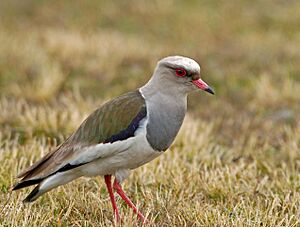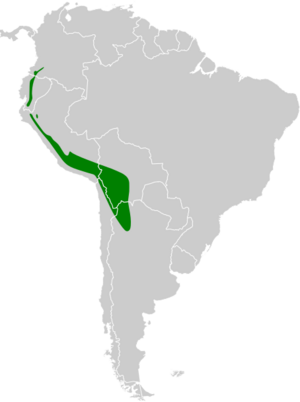Andean lapwing facts for kids
Quick facts for kids Andean lapwing |
|
|---|---|
 |
|
| Conservation status | |
| Scientific classification | |
| Genus: |
Vanellus
|
| Species: |
resplendens
|
 |
|
| Synonyms | |
|
|
The Andean lapwing (scientific name: Vanellus resplendens) is a cool type of bird. It belongs to the Charadriidae family, which includes plovers and their cousins. You can find this bird living in several South American countries like Argentina, Bolivia, Chile, Colombia, Ecuador, and Peru.
Contents
About Its Name and Family
Birds, like all living things, have scientific names to help scientists study them. The Andean lapwing was first named Charadrius resplendens. Sometimes, people have also called it Ptiloscelys resplendens. This bird is considered "monotypic," which means it's the only species in its specific group.
What Does It Look Like?
The Andean lapwing is about 33 cm (13 in) (around 13 inches) long. It usually weighs between 193 to 230 g (6.8 to 8.1 oz) (about 7 to 8 ounces). Both male and female lapwings look the same. Their feathers also stay the same color all year round.
Adult lapwings have a creamy gray head and neck. They have a dark brownish-gray patch around their eyes. Their upper body is a shiny bronzy-green. They also have a cool purple patch on their wing coverts (the small feathers covering the base of the main wing feathers).
Their chest is dark gray, and their belly is white. Their beak is pinkish-orange with a black tip. They have reddish eyes and reddish legs too. Young lapwings (juveniles) have a brownish head and neck. Their chest has buff-colored spots, and their upper body feathers have pale buff edges.
Where Does It Live?
The Andean lapwing lives in the Andes mountains. You can find it from southwestern Colombia all the way south. Its home range includes Ecuador, Peru, Bolivia, northern Chile, and northwestern Argentina.
This bird likes open spaces. It lives in places like páramo (high, cold grasslands) and puna (another type of high-altitude grassland). It also likes meadows near shores and open parts of marshes. You'll usually find them close to lakes or rivers. However, they don't like salty water.
Generally, they live at high elevations, from about 2,700 and 4,600 m (8,900 and 15,100 ft) (8,800 to 15,000 feet) high. In Chile, they can be found as high as 5,000 m (16,000 ft) (16,400 feet). In the southern parts of their range, they can live as low as 1,500 m (4,900 ft) (4,900 feet). Sometimes, during the southern winter, they might even visit the coast.
How Does It Behave?
Moving Around
Andean lapwings usually stay in the same area for most of the year. However, during the southern winter, they might move to lower places where it's not as cold.
What Does It Eat?
Scientists don't know much about how the Andean lapwing finds its food. They also don't know exactly what it eats.
How Does It Raise Its Young?
The breeding season for the Andean lapwing is mostly from October to December. Sometimes, it can last until February. Their nest is a simple dip in the ground. They line it with plant materials, including lichens. A female lapwing usually lays three or four eggs. We don't know how long it takes for the eggs to hatch or for the young birds to be ready to fly.
What Sounds Does It Make?
Like most lapwings, the Andean lapwing can be quite noisy! When it's alarmed, you might hear a sharp "wik" sound. It also makes a harsh "criee-criee-cri" call. Other sounds include a fast "cwi-cwi-cwi..." or a softer, more musical "dididi---celeec-celeec-celeec-ce...". It can also make a soft, questioning "cow" note or a low, shaky "kwiwiwiwirrr."
How Is Its Population Doing?
The IUCN (International Union for Conservation of Nature) has looked at the Andean lapwing's population. They have decided it is a species of "Least Concern." This means it's not currently in danger of disappearing.
The bird lives across a very large area. Its estimated population is under 6,700 adult birds. This number is thought to be stable, meaning it's not going down. No immediate threats have been found that would harm this bird. Because it lives in high, remote places with not many people, it's likely safe for now.


